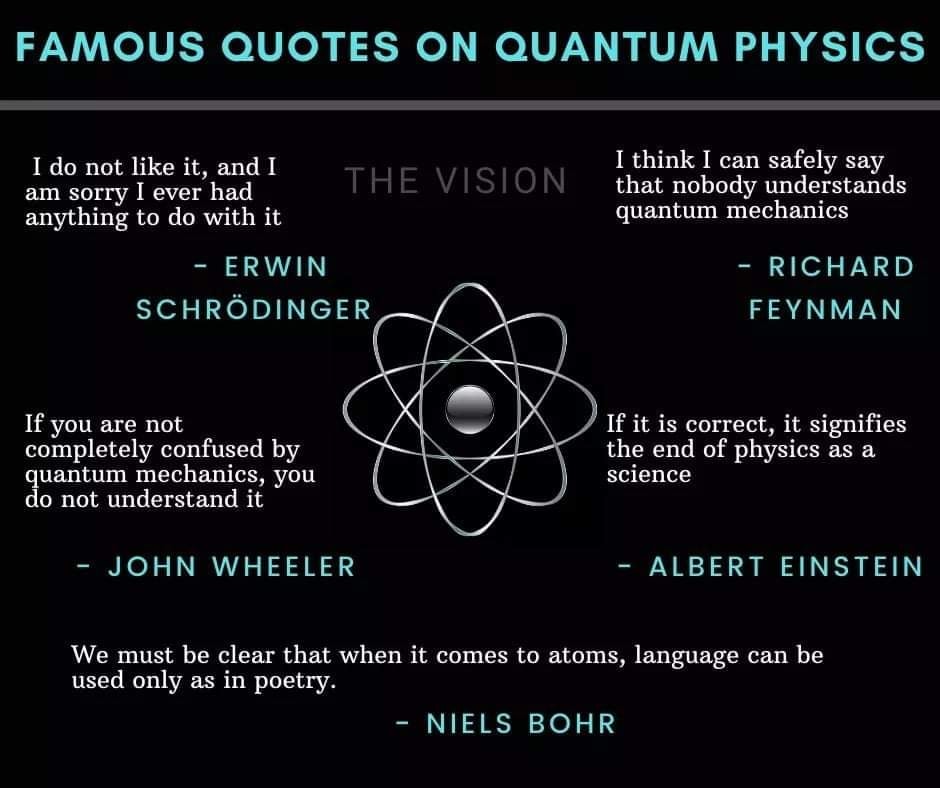
Quantum mechanics (QM; also known as quantum physics or quantum theory), including quantum field theory, is a branch of physics which is the fundamental theory of nature at small scales and low energies of atoms and subatomic particles. Classical physics, the physics existing before quantum mechanics, derives from quantum mechanics as an approximation valid only at large (macroscopic) scales. Quantum mechanics differs from classical physics in that energy, momentum and other quantities are often restricted to discrete values (quantization), objects have characteristics of both particles and waves (wave-particle duality), and there are limits to the precision with which quantities can be known (Uncertainty principle).
Quantum mechanics gradually arose from Max Planck's solution in 1900 to the black-body radiation problem (reported 1859) and Albert Einstein's 1905 paper which offered a quantum-based theory to explain the photoelectric effect (reported 1887). Early quantum theory was profoundly reconceived in the mid-1920s.
The reconceived theory is formulated in various specially developed mathematical formalisms. In one of them, a mathematical function, the wave function, provides information about the probability amplitude of position, momentum, and other physical properties of a particle.
Important applications of quantum theory include quantum chemistry, superconducting magnets, light-emitting diodes, and the laser, the transistor and semiconductors such as the microprocessor, medical and research imaging such as magnetic resonance imaging and electron microscopy, and explanations for many biological and physical phenomena. Wikipedia, Quantum Physics/Mechanics
Witches call it spells.
Christian's call it prayer.
Spiritualists call it manifestation.
Atheists call it the placebo effect.
Scientists call it quantum physics.
Everyone's arguing over it's name.
No one is denying its existence. [anon]
See Also
A Newly Discovered Law of Physics
astrophysics
Biophysics
classical physics
Field Physics
Figure 3.37 - Successive Centralizations or Quantum Leap
Journal of Sympathetic Vibratory Physics
Laws Useful in Sympathetic Vibratory Physics
Love in Science and Physics
metaphysics
nuclear physics
On the Partial Differential Equations of Mathematical Physics
particle physics
physics
plasma physics
Quantization - Physics
quantum
quantum acoustics
Quantum Arithmetic
Quantum Arithmetic Elements
quantum chromodynamics
quantum chronology
Quantum coupling
quantum electrodynamics
Quantum Entanglement
quantum field
quantum field theory
Quantum Leap
quantum mechanics
quantum number
quantum singularity
quantum state
quantum theory
Quantum Transition
Subtle Energy Physics
SVP physics and dynamics
sympathetic physics
Sympathetic Vibration v Newtonian Physics
Sympathetic Vibratory Physics
Sympathetic Vibratory Physics - An Abstract
Sympathetic Vibratory Physics - The Basic Principles
Sympathetic Vibratory Physics teaches
Sympathetic Vibratory Physics vs Quantum Entanglement
Table of Quantum Particles
The Physics of Love
The Physics of Love - Volume 2
The Physics of Love - Volume 2 Introduction
The Physics of Love 2.0
Vibratory Physics - The Connecting Link between Mind and Matter
Vibratory Physics - True Science
15.13 - Dissociating Water Acoustically - Liberation of Quantum Constituents
2.14 - Spirit as a Physics Attribute
3.22 - Quantum Leap Delta equivalent to Locked Potentials Delta
4.10 - Component Dynamics of Quantum Construction
7B.08 - The Etheric Quantum Soup
